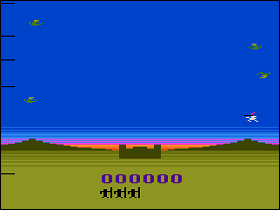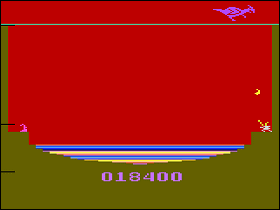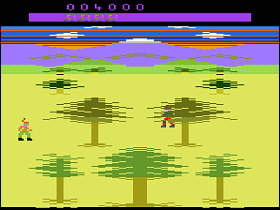 The Game: In Sir Lancelot, players assume the role of the legendary knight atop his flying steed (who knew that the Arthurian mythos could be mixed with the Greek legend of Pegasus?), battling a sky seething with dragons. Killing all the dragons on the screen will advance Lancelot to another level featuring a “boss” dragon and a damsel awaiting rescue.
The Game: In Sir Lancelot, players assume the role of the legendary knight atop his flying steed (who knew that the Arthurian mythos could be mixed with the Greek legend of Pegasus?), battling a sky seething with dragons. Killing all the dragons on the screen will advance Lancelot to another level featuring a “boss” dragon and a damsel awaiting rescue.
In Robin Hood, players don’t exactly get to rob from the rich and give to the poor; instead, the game involves hiding in the forest and exchanging volleys of arrows with the Sheriff of Nottingam and his thugs. (Xonox, 1983)
Memories: Other games archived in Phosphor Dot Fossils were produced by companies that had never produced video games before, and have never produced video games again – companies like Purina and U.S. Games, owned by Quaker Oats. Many of these johnny-come-lately entrants in the video game race knew they weren’t in it for the long haul: they were simply cashing in on a fad, and taking advantage that games could be made for the Atari 2600 without Atari‘s permission or oversight. The glut of low-quality product had a lot to do with the crash of the video game industry, but not everyone who got into the video game biz circa 1982 or ’83 was consciously pumping out stinkers.
It’s hard to tell which side of that divide Xonox landed on. A division of K-Tel, a wildly successful record label specializing in greatest hits albums and compilations of current top 40 hits (the forerunners of the “Now!” CDs), Xonox was yet another company manufacturing games for the Atari 2600 (and later – too late really – for the Colecovision) with a gimmick: double-ended cartridges that would feature two different games for the price of one. If both games were decent, this actually worked out well. If they were both stinkers, then Xonox was indeed giving it to gamers from both ends.
 On paper, pairing games about two sword-swinging heroes would seem to be an inspired idea. But in the actual execution, both games are pretty lackluster. The better of the two is easily Sir Lancelot, even if it is a bizarre stew of tried-and-true elements from other (and mostly better) games. The mechanism used to fly Lancelot’s winged horse is identical to the “flap” button from Joust – on the “small dragon” screens, in fact, game play is almost identical to Joust: the player has to climb to, and maintain, the same altitude as a dragon, and must be facing the dragon to kill it. The large dragon / lava lake screen uses the same “flapping” play mechanic, except that the dragon must be stabbed from below, and can drop firebombs on the player’s knight in the meantime. There’s little excitement to Lancelot – it alternates between boringly easy and just frustrating. Somewhere around the third level, the dragons on the first screen begin exhibiting more challenging patterns of movement, but is anyone still awake by then?
On paper, pairing games about two sword-swinging heroes would seem to be an inspired idea. But in the actual execution, both games are pretty lackluster. The better of the two is easily Sir Lancelot, even if it is a bizarre stew of tried-and-true elements from other (and mostly better) games. The mechanism used to fly Lancelot’s winged horse is identical to the “flap” button from Joust – on the “small dragon” screens, in fact, game play is almost identical to Joust: the player has to climb to, and maintain, the same altitude as a dragon, and must be facing the dragon to kill it. The large dragon / lava lake screen uses the same “flapping” play mechanic, except that the dragon must be stabbed from below, and can drop firebombs on the player’s knight in the meantime. There’s little excitement to Lancelot – it alternates between boringly easy and just frustrating. Somewhere around the third level, the dragons on the first screen begin exhibiting more challenging patterns of movement, but is anyone still awake by then?
 And that’s the better game out of the two: Robin Hood is even less engaging, as the player has to guide Robin in a dull enclosed-space exchange of fire with one villain at a time. There’s no real derring-do, no thrilling heist, no entering an archery contest to save the fair Maid Marian. In short, an ’80s video game based on a well-known legend that’s hardly short on action gaming possibilities loses out to Errol Flynn, Kevin Costner and even Walt Disney.
And that’s the better game out of the two: Robin Hood is even less engaging, as the player has to guide Robin in a dull enclosed-space exchange of fire with one villain at a time. There’s no real derring-do, no thrilling heist, no entering an archery contest to save the fair Maid Marian. In short, an ’80s video game based on a well-known legend that’s hardly short on action gaming possibilities loses out to Errol Flynn, Kevin Costner and even Walt Disney.

 Xonox’s “Double Enders” were a good idea on paper – they just needed a better pair of games than this. It’s only fitting, too, that a Double Ender gets a double rating: Sir Lancelot gets two quarters, while Robin Hood commits daylight robbery and comes up with no more than a dime.
Xonox’s “Double Enders” were a good idea on paper – they just needed a better pair of games than this. It’s only fitting, too, that a Double Ender gets a double rating: Sir Lancelot gets two quarters, while Robin Hood commits daylight robbery and comes up with no more than a dime.